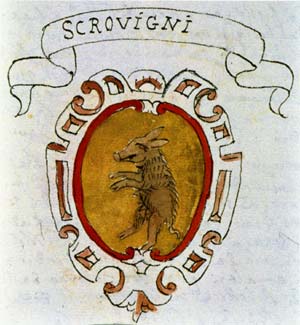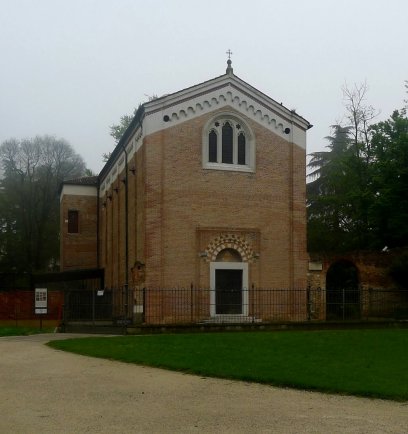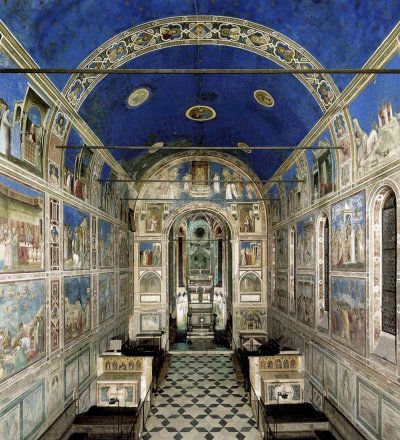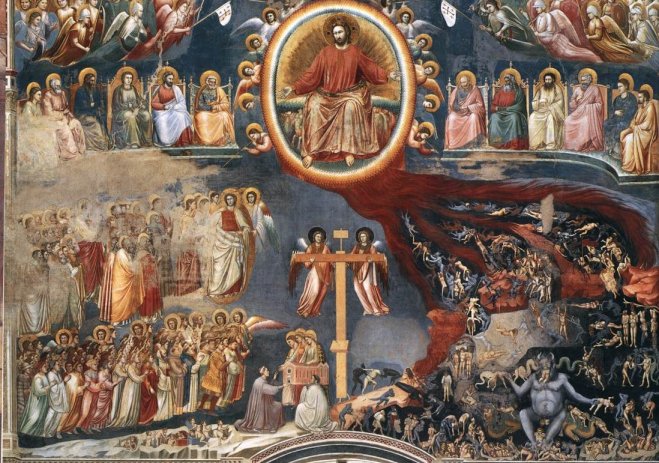So as I went gazing upon the throng,
I saw a purse display, azure on or,
The gesture and form of a lion; further along
My eye
pursued, and fell on one that bore
A purse of blood-red gules, which had on it
A goose whiter than curd; and yet one more
Beside him
sat, who on his wallet white
Showed a blue sow in farrow; this one cried
To me “What art thou doing in this pit?”
Away! And
learn (since thou has not yet died)
My neighbour Vitaliano shall come here
To sit with me upon my left-hand side.
These
Florentines keep bawling in my ear -
I’m Paduan myself – all day they shout:
‘Let come, let come that knight without a peer
Who bears
three goats upon his satchel stout!’ ”
With that he writhed his mouth awry, and made
A gross grimace, thrusting his tongue right out
Like an ox
licking his nose. Then I, afraid,
To anger him who bad me make short stay
By staying longer, left that sad brigade.
The Divine Comedy: Hell. Canto XVII
Translation by Dorothy L Sayers.
In Canto XVII Dante enters the lowest sub-circle of the seventh circle of Hell, where he meets the usurers sitting on the burning sands. Why are they here? Usury produces nothing of value to mankind, and is simply the means to gain money. The usurers are not named, but the symbols of their families appear on their purses, which gives the game away.
Last of all, Dante encountiers a usurer from Padua, whose badge is a sow: and here it is!

The sow is the symbol of the Scrovegni family: Dante is talking to Reginaldo Scrovegni, who died around 1290. Let's head for Padua and visit one of Italy's greatest artistic treasures, the Scrovegni chapel.


This was built between 1302 and 1305 by the financier Enrico
Scrovegni, the son of Reginaldo, as a small independent chapel or
oratory on the site of the Roman arena. It was decorated inside by
Giotto, perhaps his finest masterpiece, and was dedicated to Santa Maria
della Carita, St Mary of charity. So what was the building’s function?
It is generally thought that the object was to
save his wicked, usurious family from ending up in Hell. As Dante tells
us, usury was considered a grievous sin by the church. You will be aware
though, that the Church offered speedy exits from purgatory in exchange for devotions, in the form of
lots of money. This chapel doesn’t quite fit the bill as it was a
private family chapel, though it has to be said Enrico was a generous
donor to other religious buildings. It is also suggested that it might
be the means to rescue Reginaldo from Hell, though the usual view is,
once you are there, you're there for good. Dante started The Divine
Comedy in 1308, so clearly it hadn't worked for Reginaldo by then.
Here's the view of the west wall of the chapel. Here we see the last
judgement, with Paradise on the left, and the horrors of Hell on the
right. The detail shows Enrico handing the chapel over to the
Virgin Mary. Quite a clear message, then.



So what did Enrico say about his motive for
building the chapel? ‘I have solemnly dedicated a temple to the mother
of God, so that I can be blessed with an eternal award, and divine
virtue has taken the place of pagan vices.’ The last comment is a
reference to the location for the chapel, the site of a Roman age arena.
But were the family really usurers? Money-lending was strictly controlled in Padua at the time. The definition of
usury was charging interest rates over 30 p.c. Records around the time
show that the Scrovegnis charged around 20 p.c. on loans. Interesting to
compare with Pay Day loan companies today – 1500 p.c.
What a pity Dante isn’t around to deal with them.
For more on this, I recommend
the Cambridge companion to Giotto: ‘Giotto and his lay patrons’
by Benjamin G Kohl and, most important,
'The
Usurer's Heart: Giotto, Enrico Scrovegni, and the Arena Chapel in Padua’ by
Anne Derbes and Mark Sandona.